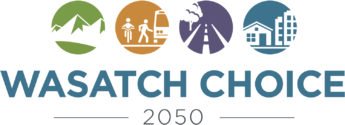
The phasing of the 2019-2050 Regional Transportation Plan (RTP) roadway, transit, and active transportation projects was guided by the Wasatch Choice 2050 (WC2050) regional goals, which were adopted by the Wasatch Front Regional Council (WFRC). These goals informed the criteria, weighting, and methodology used to phase projects, and differ slightly by transportation mode. WFRC uses a variety of tools to forecast the timing and impact of anticipated growth, such as the regional Travel Demand Model and the Real Estate Market Model. Socioeconomic and travel-related forecasts from these models are used to assign points to each transportation project in the near- and long-term time horizon. Projects are phased using technical data and input from WFRC’s partners, including the Utah Department of Transportation (UDOT), Utah Transit Authority (UTA), and local communities.
WFRC developed a two-tiered phasing process in which WFRC, in consultation with UDOT, UTA, and local communities, first identified the phase a project is needed, and then assessed financial constraints for the three phases. A project is considered to be in a certain “phase” when its construction start date is placed into a funded time horizon or an unfunded list of projects. The three phases of the 2019-2050 RTP are Phase 1: 2019 to 2030, Phase 2: 2031 to 2040, and Phase 3: 2041 to 2050.
Funding is not projected to be available for all projects and a few projects will end up being placed in the unfunded portion of the plan – although they are still considered needed by 2050.
The specific goal-centered criteria used by WFRC for phasing differ by mode. Each criterion listed a specific measure, methodology, and data requirements. The RTP’s project selection and phasing criteria within the community, community-to-region, and region-to-region by mode are as follows:
- Safe, user-friendly streets
- Manageable and reliable traffic conditions
- Access to economic and educational opportunities
- Fiscally efficient communities and infrastructure
- Livable and healthy communities
- Quality transportation choices
- Housing choices and affordable living
- Safe, user-friendly streets
- Access to economic and educational opportunities
- Fiscally efficient communities and infrastructure
- Livable and healthy communities
- Quality transportation choices
- Housing choices and affordable living
- Clean air
- Safe, user-friendly streets
- Manageable and reliable traffic conditions
- Access to economic and educational opportunities
- Livable and healthy communities
- Quality transportation choices
- Housing choices and affordable living
In an effort to refine and finalize the financially constrained Draft 2019-2050 RTP, WFRC invited stakeholders to provide feedback on the proposed timing of the transportation projects via an interactive map, offered in both English and Spanish formats.
For additional information regarding the RTP, please contact Jory Johner.

